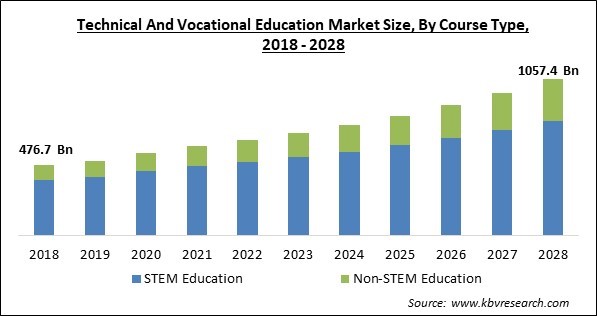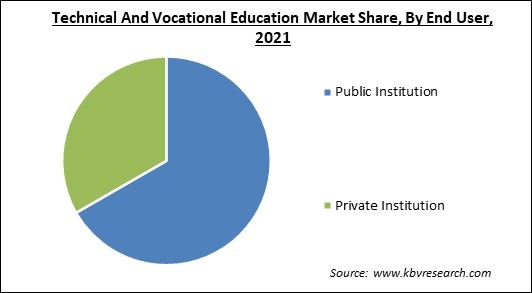The Global Technical And Vocational Education Market size is expected to reach $1057.4 billion by 2028, rising at a market growth of 8.5% CAGR during the forecast period.
The goal of Technical and vocational education and Training is multifaceted. Preparing youth for employment is a primary objective. This is accomplished via the acquisition and development of work-related skills and the mastery of fundamental knowledge and scientific concepts. Work is defined broadly and hence includes both official employment and self-employment.

To urge self-employment, technical and vocational education programs frequently incorporate training in entrepreneurship. Social reproduction and change in occupational and vocational activities are associated with this concept. Continual professional development is a related function. Rapid technological advancement necessitates that refresh their knowledge and abilities.
In contrast to the past, when a job might be retained for life, it is now usual to switch careers several times, technical and vocational education facilitates this adaptability in two ways. One involves imparting broad technical knowledge and transferable abilities upon which many jobs may be built. The second is providing workers with ongoing vocational training.
In contrast to the industrial paradigm of the old economy, the worker in today's global economy must perpetually reinvent him or herself. In the past, full-time employment, specific professional duties, and well-established career trajectories guaranteed employees a job for life. The knowledge-based global economy is characterized by fast technological and work-related developments. Frequently, workers find themselves deemed redundant and unemployed.
Today, technical and vocational education is responsible for retraining these workers so they may find and return to employment. Technical and vocational education is not just a venue for work-related education, but also personal growth and independence. This refers to the development of those human capacities that pertain to the achievement of one's full potential in terms of paid or self-employment, occupational interests, and non-work-related life objectives. Technical and vocational education also aims to allow individuals to overcome obstacles resulting from birth circumstances or earlier educational experiences.
The scope of the technical and vocational education and training disruption caused by COVID-19 is simply amazing. The COVID-19 pandemic prompted massive attempts to enhance learning continuity and hastened the adoption of novel techniques. After discontinuing face-to-face learning, many providers of technical and vocational education and training hurried to shift to remote learning modalities, creating solutions and partners to enable this transition and providing support for students and tutors. In the majority of nations, responding technical and vocational education providers lacked a crisis readiness strategy, and few had ever engaged in distance learning.
The fundamental principle of vocational education training is "learning by doing." Practical learning takes precedence over theoretical learning. Significantly more time is devoted in vocational schools to the practice of actual skills that students will need and may apply in the job. The focus of their education is on learning the skills and information required to perform effectively in their chosen sector. This method of education incorporates work experience directly into the curriculum, rather than requiring students to pursue internships or entry-level employment outside of class time.
As most vocational courses may be finished in two years or less, vocational education is often a low-cost option for individuals. The tuition and other costs associated with this field of study are lower than those of other types of colleges. This further contributes to the cost savings students experience during their studies. They pay less each year they are in school, which reduces any debt they must incur to pay for school.
Part of the difficulty that technical and vocational education has in promoting social equality is equipping underprivileged kids and adults with the appropriate skills and assisting them in making the transition from school to employment. Depending on the contextual dynamics of inclusion and exclusion, as well as the skills of individuals, ensuring an inclusive workplace presents several policy problems. For instance, the exclusionary experiences of individuals with disabilities and underprivileged women may be comparable in some respects and unlike in others.

Based on the Course Type, the Technical and Vocational Education Market is segmented into STEM Education and Non-STEM Education. The STEM education segment acquired the highest revenue share in the technical and vocational education market. Science, technology, engineering, and mathematics (STEM) education has been accepted by several nations due to its ability to promote the social and economic growth of populations. Globally, a large number of businesses provide STEM learning courses.
On the basis of End-user, the Technical and Vocational Education Market is divided into Academic Institutions and Individuals and Corporate workers. The Academic Institutions & Individuals segment procured the largest revenue share in the technical and vocational education market in 2021. It is because the proportion can be linked to the availability of these courses at academic institutions. Additionally, students enroll in these courses through academic institutions to obtain better employment.
By Learning Mode, the Vocational Education Market is classified into Online and Offline. The Online segment registered a significant revenue share in the technical and vocational education market in 2021. It is due to the increasing need for digitalization, accessibility, more advanced information, and communication technology, and improved protection for sensitive data. In addition, freedom in determining the location, time, and speed of learning for both students and instructors is one of the primary advantages of online learning over traditional learning.
Based on the Organization, the Technical and Vocational Education Market is bifurcated into Public Institution and Private Institutions. The public Institution segment acquired the largest revenue share in the technical and vocational education market in 2021. The majority of technical and vocational education is offered by state institutions. Several nations, like Germany and France, offer free public institutions for vocational education. Countries like the United States and Canada have a high prevalence of vocational education in their public schools.
| Report Attribute | Details |
|---|---|
| Market size value in 2021 | USD 608.5 Billion |
| Market size forecast in 2028 | USD 1057.4 Billion |
| Base Year | 2021 |
| Historical Period | 2018 to 2020 |
| Forecast Period | 2022 to 2028 |
| Revenue Growth Rate | CAGR of 8.5% from 2022 to 2028 |
| Number of Pages | 233 |
| Number of Tables | 400 |
| Report coverage | Market Trends, Revenue Estimation and Forecast, Segmentation Analysis, Regional and Country Breakdown, Companies Strategic Developments, Company Profiling |
| Segments covered | Course Type, Learning Mode, Organization, End-user, Region |
| Country scope | US, Canada, Mexico, Germany, UK, France, Russia, Spain, Italy, China, Japan, India, South Korea, Singapore, Malaysia, Brazil, Argentina, UAE, Saudi Arabia, South Africa, Nigeria |
| Growth Drivers |
|
| Restraints |
|
Region-wise, the Technical and Vocational Education Market is analyzed across North America, Europe, Asia Pacific, and LAMEA. The Asia Pacific segment procured a promising growth rate in the technical and vocational education market in 2021. It is due to the rise of the sector such as cutting-edge innovations, such as the hybrid model, quickly developing technical improvements, rising awareness of vocational training, and peer-to-peer learning to bridge the gap between education and employment needs.
Free Valuable Insights: Global Technical And Vocational Education Market size to reach USD 1057.4 Billion by 2028
The market research report covers the analysis of key stake holders of the market. Key companies profiled in the report include Acumatica, Inc., Amazon Web Services, Inc. (Amazon.com, Inc.), Adobe Inc., Articulate Global, LLC, IBM Corporation, TÜV Rheinland AG, Babcock International Group PLC (Scandinavian AirAmbulance), Pitman Training Group Ltd. (Launch Life International, Inc.), The CEGOS Group, and The Center for Professional Advancement (CfPA).
By Course Type
By End User
By Learning Mode
By Organization
By Geography
The global Technical And Vocational Education Market size is expected to reach $1057.4 billion by 2028.
The Emphasis On Practical Abilities are driving the market in coming years, however, Promoting Social Justice And Inclusive Work Environments restraints the growth of the market.
Acumatica, Inc., Amazon Web Services, Inc. (Amazon.com, Inc.), Adobe Inc., Articulate Global, LLC, IBM Corporation, TÜV Rheinland AG, Babcock International Group PLC (Scandinavian AirAmbulance), Pitman Training Group Ltd. (Launch Life International, Inc.), The CEGOS Group, and The Center for Professional Advancement (CfPA).
The STEM Education segment acquired maximum revenue share in the Global Technical And Vocational Education Market by Course Type 2021 thereby, achieving a market value of $776.1 Billion by 2028.
The Offline segment is leading in the Global Technical And Vocational Education Market by Learning Mode 2021, achieved a market value of $544.4 Billion by 2028.
The Europe market dominated the Global Technical And Vocational Education Market by Region 2021, and would continue to be a dominant market till 2028; thereby, achieving a market value of $354.5 Billion by 2028.
Our team of dedicated experts can provide you with attractive expansion opportunities for your business.

